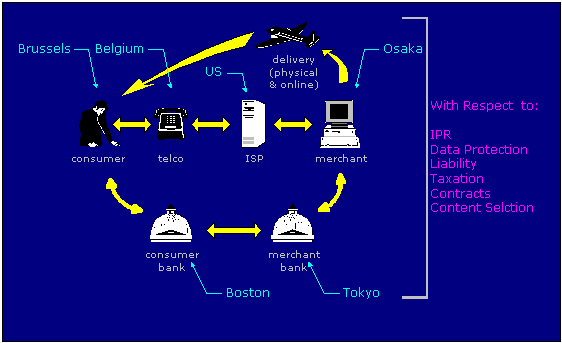CS Is More Than Just Technology
W3C's Technology and Society Domain
- People-to-People, mediated by computers
- Applications of Web Technology
- What do people want to do?
- What technology is needed?
- Public Policy
- ...can promote or inhibit growth of the Web
- ...needs to be technology sensitive
- ...must respect the global nature of the Web
Core Technologies
- Metadata (PICS, XML, and beyond)
- Negotiation (PEP and above)
- Cache coherence and correctness
T & S Projects and Working Groups
Existing work
- PICS (metadata), Paul Resnick (AT&T Labs)
- JEPI (payment negotiation)
- Digital Signature Initiative (Trust: metadata, signatures, and PKI)
- Access for the Disabled
Proposed work
- Privacy and Data Protection (P3)
- Intellectual Property Rights
Public Policy Mission
...Since the Web is global, its technology must support a wide range
of policy options that encourage all cultures to use the Web. ...[T]he
W3C must be aware of and apply an understanding of public policy.
...[The Web's] architecture must allow local policies to co-exist
without cultural fragmentation or domination. In addition, W3C can
provide feedback to policy makers regarding: what is technically
possible; how effectively the technology can meet policy requirements;
and possible unintended consequences of proposed policies.
Engineering under Policy Constraints
Good engineering requires flexibility, layering and modularity
- Requirements may differ across technical constituencies
and time.
When engineering becomes closely coupled to a specific policy,
the technology is seen as biased.
When contentious policy issues are embedded in the engineering
process, there is more policy debate than engineering.
By supporting a range of policy options we decouple policy
debates from engineering.
Web Technology and Policy
Developing web technology in the policy domain is hard

Relationship: Technology and Policy
Some technologies are intrinsically limited to serving certain
policies effectively.
- Nuclear bombs are poor at improving air quality.
Other technologies can effectively serve multiple policies.
- Guns can be used to effectively "hunt" or
"shoot the enemy."
Relationship: Technology and Policy, cont'd
A useful pair of strategies for technologists is to
- find the right "layer" for addressing policy
issues and
- delimit the range of options which they will support.
For example,
- TCP/IP is merely a communications protocol that cares
nothing for what is said or who said it. (L18)
- PICS allows anyone to comment on a Web resource.
The W3C's Challenges in the Policy Domain
- Defining Our Mission and Role
- Supporting The Web as A Global Phenomenon
- Enabling Multiple Policies
- Sharing the Vision
Defining our Mission and Role
The mission of the World Wide Web Consortium (W3C) is to
"realize the full potential of the Web."
- Ensure technical cohesiveness.
- Encourage a global space.
- Multiple cultures can coexist on the Web.
- A diversity of viewpoints can be represented.
- Enable Electronic Commerce.
Defining our Mission and Role, cont'd
The W3C's central focus is the technology. We recognize that
it takes more than just technical knowledge to build good
technology.
Good policy requires an understanding of technology. Our role
is to help people to understand the Web and its technology.
We cannot advocate particular policy positions, but recognize
the importance of these discussions.
Supporting the Web as A Global Phenomenon
The W3C is an international forum.
Originally our concern was technical fragmentation
(interoperability)
We now recognize preventing cultural and economic
fragmentation are equally important to the sucess of the Web.
Enabling Multiple Policies
In all of our projects we need to understand the greater
context:
- The critical issues.
- The range of policies.
- The stakeholders and their views.
Enabling Multiple Policy, cont'd
Supporting multiple policies can be contentious:
- Some policies may not be supported.
- Some supported policies may be subject to criticism.
- Some people may not wish to permit a range of policy
options.
The arguments of "where to draw line" and "if
to draw line" are often confused.
Cases in point: PICS, JEPI, IPR
Sharing the Vision
The W3C
- Is a vendor neutral source about Web technology.
- Can serve as an expert source of information on how
technology can be effectively used.
- Can help others understand possible unintended
consequences of proposed policies.
W3C Policy Statement
The mission of the World Wide Web Consortium
(W3C) is to "realize the full potential of the Web."
Since the Web is global, its technology must support a wide range
of policy options that encourage all cultures to use the Web. To
support this mission in the context of a global information
space, the W3C must be aware of and apply an understanding of
public policy (which may inhibit or promote the growth of the
Web) towards Web technology. W3C works on behalf of and with its
membership to build and maintain an inter-operable network
architecture. This architecture must allow local policies to
co-exist without cultural fragmentation or domination. In
addition, W3C can provide feedback to policy makers regarding:
what is technically possible; how effectively the technology can
meet policy requirements; and possible unintended consequences of
proposed policies.

